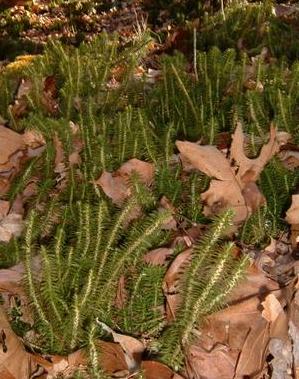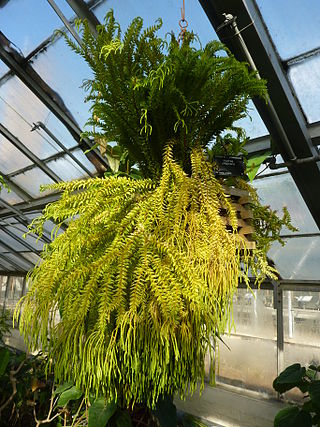
Huperzia is a genus of lycophyte plants, sometimes known as the firmosses or fir clubmosses; the Flora of North America calls them gemma fir-mosses. This genus was originally included in the related genus Lycopodium, from which it differs in having undifferentiated sporangial leaves, and the sporangia not formed into apical cones. The common name firmoss, used for some of the north temperate species, refers to their superficial resemblance to branches of fir (Abies), a conifer. As of 2020, two very different circumscriptions of the genus were in use. In the Pteridophyte Phylogeny Group classification of 2016, Huperzia is one of three genera in the subfamily Huperzioideae of the family Lycopodiaceae. Most species in the subfamily are placed in the genus Phlegmariurus. Huperzia is left with about 25 species, although not all have been formally transferred to other genera. Other sources recognize only Huperzia, which then has about 340 species.

Huperzioideae is a subfamily of lycopsids in the family Lycopodiaceae. It has sometimes been recognized as a separate family, Huperziaceae. The Pteridophyte Phylogeny Group classification of 2016 recognizes three extant genera:

The Lycopodiaceae are an old family of vascular plants, including all of the core clubmosses and firmosses, comprising 16 accepted genera and about 400 known species. This family originated about 380 million years ago in the early Devonian, though the diversity within the family has been much more recent. "Wolf foot" is another common name for this family due to the resemblance of either the roots or branch tips to a wolf's paw.
Phlegmariurus ascendens is a species of plant in the family Lycopodiaceae. It is endemic to Ecuador. Its natural habitat is subtropical or tropical high-altitude grassland. It is threatened by habitat loss.
Phlegmariurus austroecuadoricus is a species of plant in the family Lycopodiaceae. It is endemic to Ecuador. Its natural habitats are subtropical or tropical moist montane forest and subtropical or tropical high-altitude grassland. It is threatened by habitat loss.
Phlegmariurus columnaris is a species of plant in the family Lycopodiaceae. It is endemic to Ecuador.
Phlegmariurus compactus is a species of plant in the family Lycopodiaceae. It is endemic to Ecuador, where it is distributed throughout the southern Andean páramos. It occurs up to 4500 meters in altitude.
Phlegmariurus cumingii is a species of plant in the family Lycopodiaceae. It is endemic to Ecuador. Its natural habitats are subtropical or tropical moist montane forest and subtropical or tropical high-altitude grassland.
Phlegmariurus espinosanus is a species of plant in the family Lycopodiaceae. It is endemic to Ecuador. Its natural habitat is subtropical or tropical high-altitude grassland. It is threatened by habitat loss.
Phlegmariurus hastatus is a species of plant in the family Lycopodiaceae. It is endemic to Ecuador, where it is known from two locations in Loja Province. It grows on the páramo, where it is threatened by grazing and fire.
Phlegmariurus llanganatensis is a species of plant in the family Lycopodiaceae. It is endemic to Ecuador. Its natural habitat is subtropical or tropical high-altitude grassland. It is threatened by habitat loss.
Phlegmariurus loxensis is a species of plant in the family Lycopodiaceae. It is endemic to Ecuador, where it occurs in the páramo and forests of the Andes. It is threatened by fire in its habitat.
Phlegmariurus polydactylus is a species of plant in the family Lycopodiaceae. It is characterized by its slender, creeping stems, and spear-shaped leaves. It is endemic to Ecuador. Its natural habitats are subtropical or tropical moist montane forest and subtropical or tropical high-altitude grassland. It is threatened by habitat loss.
Phlegmariurus scabridus is a species of plant in the family Lycopodiaceae. It is endemic to Ecuador. Its natural habitats are subtropical or tropical moist montane forest and subtropical or tropical high-altitude grassland. It is threatened by habitat loss.
Phlegmariurus talpiphilus is a species of plant in the family Lycopodiaceae. It is endemic to Ecuador. Its natural habitat is subtropical or tropical high-altitude grassland. It is threatened by habitat loss.
Phlegmariurus nutans, synonym Huperzia nutans, known as wawaeʻiole or nodding clubmoss, is a species of club moss in the family Lycopodiaceae. It is endemic to wet forests and cliffside shrublands on the islands of Oahu and Kauai in Hawaii. It is threatened by habitat loss.

Phlegmariurus phlegmaria, synonym Huperzia phlegmaria, commonly known as either coarse tassel fern or common tassel fern, is an epiphytic species native to rainforests in Madagascar, some islands in the Indian Ocean, Asia, Australasia and many Pacific Islands. Phlegmariurus phlegmaria is commonly found in moist forests and rainforests at high altitudes, in and amongst mosses and other epiphytes. Members of the order Lycopodiales are commonly referred to as clubmosses.
Phlegmariurus mannii, synonym Huperzia mannii, is a species of lycopod, known by the common names Mann's clubmoss and wawaeʻiole. It is endemic to Hawaii, where there are only six populations remaining. It is a federally listed endangered species of the United States.

Phlegmariurus crassus is a lycophyte found in Central and South America.

Phlegmariurus squarrosus is a species of lycophyte in the family Lycopodiaceae. The genus Phlegmariurus is accepted in the Pteridophyte Phylogeny Group classification of 2016, but not in other classifications, which submerge the genus in Huperzia, with this species as Huperzia squarrosa. The species has a wide distribution from the west Indian Ocean, through tropical and subtropical Asia to eastern Australia and the Pacific.






